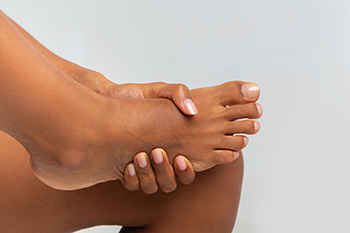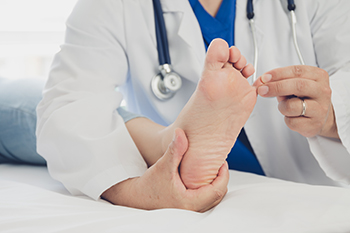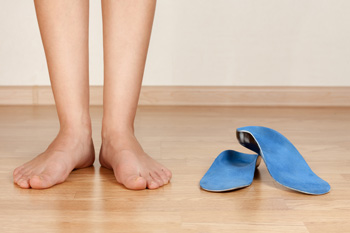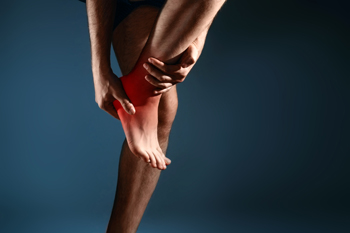August 2022
Causes of Tarsal Tunnel Syndrome

The medical term for the foot condition known as tarsal tunnel syndrome is posterior tibial neuralgia. It can cause severe pain and discomfort as a result of a compressed tibial nerve as it travels through the tarsal tunnel. Patients who experience this ailment may have a predisposition to diabetes, alcoholism, or specific types of neuropathies. The symptoms that are often associated with tarsal tunnel syndrome consist of tenderness surrounding the ankle, a lack of feeling in the sole, and difficulty walking or standing. It may be a frequent ailment among people who have flat feet, and the fallen arch may begin to compress the nerve. Additionally, if a foot injury has occurred, it may damage the tarsal tunnel and the nerve that is inside it. If you have any of the above symptoms, it is suggested that you have a physical examination from a podiatrist who can accurately diagnose and treat this condition.
Tarsal tunnel syndrome can be very uncomfortable to live with. If you are experiencing tarsal tunnel syndrome, contact Dawn Miles, DPM of Florida. Our doctor can provide the care you need to keep you pain-free and on your feet.
Tarsal Tunnel Syndrome
Tarsal tunnel syndrome, which can also be called tibial nerve dysfunction, is an uncommon condition of misfiring peripheral nerves in the foot. The tibial nerve is the peripheral nerve in the leg responsible for sensation and movement of the foot and calf muscles. In tarsal tunnel syndrome, the tibial nerve is damaged, causing problems with movement and feeling in the foot of the affected leg.
Common Cause of Tarsal Tunnel Syndrome
- Involves pressure or an injury, direct pressure on the tibial nerve for an extended period of time, sometimes caused by other body structures close by or near the knee.
- Diseases that damage nerves, including diabetes, may cause tarsal tunnel syndrome.
- At times, tarsal tunnel syndrome can appear without an obvious cause in some cases.
The Effects of Tarsal Tunnel Syndrome
- Different sensations, an afflicted person may experience pain, tingling, burning or other unusual sensations in the foot of the affected leg.
- The foot muscles, toes and ankle become weaker, and curling your toes or flexing your foot can become difficult.
- If condition worsens, infections and ulcers may develop on the foot that is experiencing the syndrome.
A physical exam of the leg can help identify the presence of tarsal tunnel syndrome. Medical tests, such as a nerve biopsy, are also used to diagnose the condition. Patients may receive physical therapy and prescriptive medication. In extreme cases, some may require surgery.
If you have any questions please feel free to contact one of our offices located in Palatka and Saint Augustine, FL . We offer the newest diagnostic and treatment technologies for all your foot and ankle needs.
What Does a Podiatrist Treat?

A podiatrist is a specialized doctor whose main concern is the health of your ankles, feet and toes. Podiatrists can help improve mobility, relieve pain, and treat infections. They often play a role in treating chronic conditions, such as diabetes, which can adversely affect the feet. A podiatrist can offer advice on proper foot care and selecting footwear that fosters healthy feet and ankles. They also can create custom orthotic shoe inserts that work specifically to counteract any foot, gait, or other abnormalities you may have. Among the many conditions that a podiatrist can treat are ingrown toenails, corns and calluses, flat feet, bunions, plantar warts, and heel pain. In addition, podiatrists conduct surgery, reset broken bones, prescribe medications, and order lab tests, X-rays, and imaging tests. Podiatrists attend special podiatry colleges for four years and work in hospitals for three more years. They also get advanced certifications to perform surgery on feet and ankles and acquire the title of Doctor of Podiatric Medicine, or DPM, after their name. For help with your ankle, foot or toe problems, please make an appointment with a podiatrist.
If you are experiencing pain in the feet or ankles, don’t join the stubborn majority refusing treatment. Feel free to contact Dawn Miles, DPM from Florida. Our doctor can provide the care you need to keep you pain-free and on your feet.
What Is a Podiatrist?
Someone would seek the care of a podiatrist if they have suffered a foot injury or have common foot ailments such as heal spurs, bunions, arch problems, deformities, ingrown toenails, corns, foot and ankle problems, etc.
Podiatric Treatment
A podiatrist will treat the problematic areas of the feet, ankle or lower leg by prescribing the following:
- Physical therapy
- Drugs
- Orthotic inserts or soles
- Surgery on lower extremity fractures
A common podiatric procedure a podiatrist will use is a scanner or force plate which will allow the podiatrist to know the designs of orthotics. Patients are then told to follow a series of tasks to complete the treatment. The computer will scan the foot a see which areas show weight distribution and pressure points. The podiatrist will read the analysis and then determine which treatment plans are available.
If you have any questions please feel free to contact one of our offices located in Palatka and Saint Augustine, FL . We offer the newest diagnostic and treatment technologies for all your foot and ankle needs.
Food Servers and Foot Care

Many individuals earn their living by working as food servers, waiters, or waitresses. If you work as a food server, you are no doubt familiar with the fact that food servers spend the majority of the day working on their feet. Whether you are walking to and from the kitchen or carrying heavy dishes of food to tables, you spend a significant amount of the work day putting pressure on your feet. If you are not diligent about maintaining a foot care routine, you might be setting yourself up for a foot injury or condition. First, ensure that you are wearing the right kind of footwear on the job. Instead of wearing shoes with high heels that can increase your risk of falling during your shift, wear shoes with low, wide heels to provide stability. Second, since food servers spend such long amounts of time working on their feet, be sure to take the time you need to relax and pamper your feet. You may choose to give yourself a foot massage or to receive one professionally. These foot massages can relax muscles and ligaments in the feet, preventing tightening that could lead to injuries. Third, it is a good idea to be diligent about keeping your feet clean. For example, you might wash your feet to remove damaging bacteria, and pat them dry completely. Food servers ought to take the health of their feet seriously. If you work in the food service industry, contact a podiatrist to understand the best way to care for your feet.
While working on the feet, it is important to take the proper care of them. For more information about working on your feet, contact Dawn Miles, DPM from Florida. Our doctor will treat your foot and ankle needs.
Working on Your Feet
Standing on your feet for long periods of time can cause stress and pain in your feet. Your whole body may experience change in terms of posture, back pain, bunions, callouses and or plantar warts. There are ways to avoid these conditions with proper foot care, smart choices and correct posture.
Positive Changes
Negative heeled shoe – Choosing this shoe type places the heel slightly lower than the ball of the foot. These are great for overall foot health. Find shoes that fit you correctly.
Go barefoot – Our feet were not designed to be enclosed for all hours of the day. Try to periodically expose your feet to air.
Eliminate Pain
Foot Exercises – Performing simple exercises, incorporating yoga and doing stretches are beneficial. This will allow increased blood flow to the area and muscles of the foot.
Achilles tendon – Stretching the foot out flat on the floor will relax the calf muscles and tendon. These exercises can be performed almost anywhere. Make sure you add these exercises to your daily regimen.
With a little bit of this information and knowing more about foot health, you will notice changes. Foot stretches and proper footwear will help with pain and prevent further issues.
If you have any questions please feel free to contact one of our offices located in Palatka and Saint Augustine, FL . We offer the newest diagnostic and treatment technologies for all your foot and ankle needs.
Prefabricated Versus Custom Orthotics

Prefabricated orthotics is another name for over-the-counter (OTC) orthotics. Custom orthotics are constructed to the precise specifications of your foot. With certain foot conditions, such as plantar fasciitis or flatfoot, there is evidence that prefabricated or custom orthotics help. They are not considered to help as much for overuse injuries like tendonitis or stress fractures. Rigid, or very stiff orthotics, can help control the foot position during walking but must exert force against the plantar part of the foot that is three to four times one’s body weight. Rigid orthotics are not particularly comfortable either, and less of this type of orthotic is used. Most often, one wears semi-rigid or accommodative orthotics, and they act almost like a bed for the foot spreading the weight more evenly across the surface of the footwear. When there is an abnormality of the foot, custom orthotics are thought to be better. Know that no orthotic—custom or OTC—will be able to treat all foot problems. Consult with a podiatrist to see which type is best for your condition.
If you are having discomfort in your feet and would like to try orthotics, contact Dawn Miles, DPM from Florida. Our doctor can provide the care you need to keep you pain-free and on your feet.
What Are Orthotics?
Orthotics are inserts you can place into your shoes to help with a variety of foot problems such as flat feet or foot pain. Orthotics provide relief and comfort for minor foot and heel pain but can’t correct serious biomechanical problems in your feet.
Over-the-Counter Inserts
Orthotics come in a wide variety of over-the-counter inserts that are used to treat foot pain, heel pain, and minor problems. For example, arch supports can be inserted into your shoes to help correct overarched or flat feet, while gel insoles are often used because they provide comfort and relief from foot and heel pain by alleviating pressure.
Prescription Orthotics
If over-the-counter inserts don’t work for you or if you have a more severe foot concern, it is possible to have your podiatrist prescribe custom orthotics. These high-quality inserts are designed to treat problems such as abnormal motion, plantar fasciitis, and severe forms of heel pain. They can even be used to help patients suffering from diabetes by treating foot ulcers and painful calluses and are usually molded to your feet individually, which allows them to provide full support and comfort.
If you are experiencing minor to severe foot or heel pain, it’s recommended to speak with your podiatrist about the possibilities of using orthotics. A podiatrist can determine which type of orthotic is right for you and allow you to take the first steps towards being pain-free.
If you have any questions please contact one of our offices located in Palatka and Saint Augustine, FL . We offer the newest diagnostic and treatment technologies for all your foot and ankle needs.
Reminder: When Was the Last Time...?
Common Ways to Deal With Foot Pain

There are many and varied causes of foot pain, including injury, overuse, or conditions that result in inflammation involving bones, ligaments, and tendons. Arthritis and neuropathy are also common causes of foot pain, as are deformities like bunions and hammertoe. A number of methods are available to combat foot pain. A warm foot bath containing Epsom salt can be soothing to sore muscles after a long day of walking or standing. But if your feet are hot, swollen, and tired, a cool foot bath may be more effective. A simple foot massage with essential oils can also help reduce pain and promote flexibility. Exercise also has been shown to counteract muscle tightness. Of course, footwear is often one of the problems frequently associated with foot pain. Make sure that your shoes fit properly, providing ample toe room and adequate cushioning. Have corns and calluses that cause you to change walking patterns looked at and removed. If you have flat feet, or other foot deformities, custom orthotics may help alleviate pain. For more information on why you have foot pain and what to do about it, please consult a podiatrist.
Foot Pain
Foot pain can be extremely painful and debilitating. If you have a foot pain, consult with Dawn Miles, DPM from Florida. Our doctor will assess your condition and provide you with quality foot and ankle treatment.
Causes
Foot pain is a very broad condition that could be caused by one or more ailments. The most common include:
- Bunions
- Hammertoes
- Plantar Fasciitis
- Bone Spurs
- Corns
- Tarsal Tunnel Syndrome
- Ingrown Toenails
- Arthritis (such as Gout, Rheumatoid, and Osteoarthritis)
- Flat Feet
- Injury (from stress fractures, broken toe, foot, ankle, Achilles tendon ruptures, and sprains)
- And more
Diagnosis
To figure out the cause of foot pain, podiatrists utilize several different methods. This can range from simple visual inspections and sensation tests to X-rays and MRI scans. Prior medical history, family medical history, and any recent physical traumatic events will all be taken into consideration for a proper diagnosis.
Treatment
Treatment depends upon the cause of the foot pain. Whether it is resting, staying off the foot, or having surgery; podiatrists have a number of treatment options available for foot pain.
If you have any questions, please feel free to contact one of our offices located in Palatka and Saint Augustine, FL . We offer the newest diagnostic and treatment technologies for all your foot care needs.










